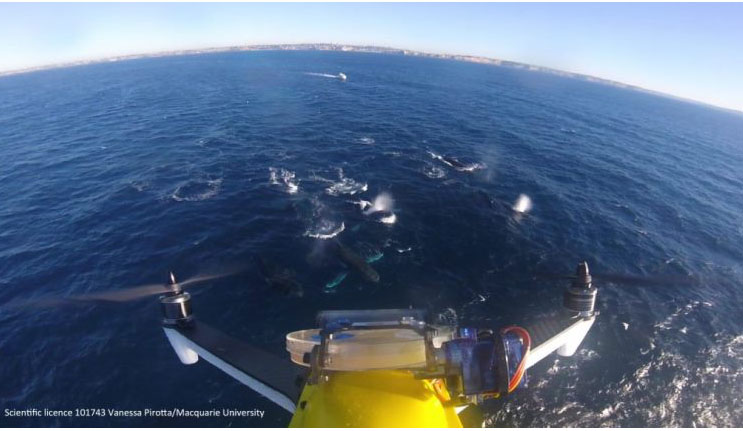
RESEARCH NEWS
Boogie flights: how scientists are monitoring whale health by using drones to collect their blow
Macquarie University researchers have led the design and construction of a new system that can be fitted to a custom-built, waterproof drone* in order to sample whale microbiota (the combination of natural bacterial colonies that live in an organism) by flying over and collecting the exhaled vapours from their blowholes.
The collaborative research project, led by Macquarie University’s Department of Biological Sciences, involved an array of experts including drone pilot and engineer Alastair Smith from Heliguy Pty. Ltd., Sydney, sea vessel experts, microbiologists and marine biologists, used the customised drone collection technique in order to monitor the health of whales in a non-invasive manner.
“In conjunction with drone experts, we have developed a low-cost system which incorporates a sterile petri dish with a remotely operated and novel ‘flip lid’. This can be attached to a drone along with a GoPro camera in order to sample whale blow with minimal disturbance to the whales,” explained lead researcher Vanessa Pirotta from the Department of Biological Sciences.
“This system allowed us to collect samples safely and reliably, by minimising external contamination such as air and seawater from outside the blowhole” Pirotta added.
Whereas previous collection of mucus from whales has involved taking samples from beached animals, where their health is already compromised, or from a boat which comes with its own set of risks, such as close approaches to very large animals, the researchers in this study were able to non-invasively collect mucus microbiota samples from 59 actively northward migrating humpback whales off the coast of Sydney. They then extracted bacterial DNA in the lab and sequenced the samples to identify the specific bacteria present in a sample. Interestingly, in addition to having bacteria that is usually found in mammals, the humpback whales were also found to have bacteria in their blow mucus from non-mammalian species.
“We were able to see that many of the whales had types of bacteria that are found in the respiratory tracts of dolphins and oral cavities of other mammals, but we also found some bacteria that has been associated with fish,” Pirotta explained.
The researchers say that by understanding the microbiota that lives in the blow mucus of healthy whales, they will be able to monitor changes in individuals and entire populations which could connote a change or decline in health.
“Gathering baseline information of whale lung microbiota provides a snapshot of health information from an animal that is uncatchable. This means we will be better able to monitor the health of recovering whale populations over time and look for changes in their environment. We also hope to adapt this method to learn more about the health of other species such as the much smaller Southern right whale population,” said Pirotta.
As for the research team’s future endeavours, Pirotta says that they are keen to see how drones could help them learn about other aspects of whale health and ecology.
“In the marine environment, drones are revolutionising the way we study marine species. Due to their small size, the fact that they cause minimal disturbance to wildlife and offer improved safety for both operators and animals, makes them an attractive option for studying marine wildlife. In addition to collecting health information, we were also able to capture a different perspective of whale behaviour off Sydney not seen from a boat. We saw whales interacting with each other underwater and huge numbers of dolphins escorting whale pods as they travelled north. We hope to optimise our device, and develop new ways to answer questions about whales and other marine species as well,” Pirotta concluded.
*Please note that the use of drones around wildlife is restricted and closer approach to marine mammals using drones is only permitted under a scientific licence and with CASA approval. Current restrictions when approaching a marine mammal in an unmanned aircraft (including drones) without a scientific licence specify that aircraft must maintain a height at least 100 metres above the animal/s and also maintain a 100 metre horizontal radius away from the animal/s, under the Biodiversity Conservation Regulation 2017 which came into effect on 25 August 2017.
Dr Pirrotta
Where U able o get ANY Mucus samples from Orcas or Killer whales as this year many more Orcas where sited as the annual migration of the Humpbacks headed South. As Marine researcher I have specialised in Stranding’s along the East coast of Australia. Please check out my site on sylviaadam.wordpress.com I have some research material and hoping to find a student to use it as a Masters Degree. PLEASE contact me at your convenience.